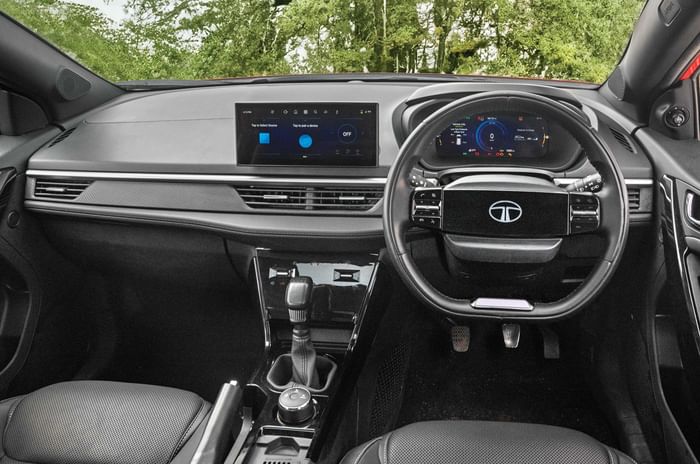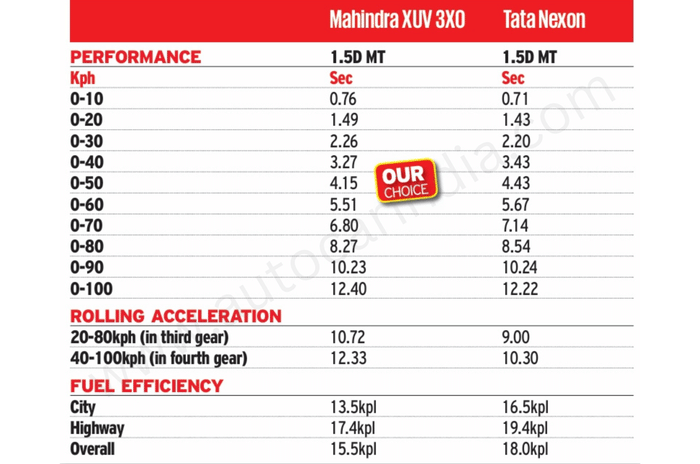Mahindra XUV 3XO vs Tata Nexon diesel comparison
We put the Mahindra XUV 3XO diesel through our exhaustive tests, and to get some perspective, we compare it to the Nexon diesel.
Published on Nov 20, 2024 03:00:00 PM
46,162 Views
Follow us on

High-quality interior feels bright and airy thanks to the use of light colours. Fit, finish and quality are very good.

Floating touchscreen and touch keys for climate control look modern. Dark cabin hampers the sense of space.
Both the cars are powered by 1.5-litre, four-cylinder turbo-diesel engines mated to 6-speed manual transmissions. But that’s where their similarities end. To meet stringent BS6.2 emissions norms, Tata uses a Lean NOx Trap (LNT) and diesel particulate filter (DPF). It is accompanied by the cost-effective Passive Selective Catalytic Reduction that eliminates the need for a urea tank and an injection system, which are a part of the Selective Catalytic Reduction (SCR) system. The XUV 3XO diesel deploys the latter, which is more expensive as it warrants a separate AdBlue tank and other ancillaries. It also needs regular maintenance as owners have to refill the AdBlue tank at fixed intervals, which is an added cost.
Right off the bat, the Mahindra’s diesel feels smoother and more refined. Yes, you can hear some diesel clatter at idle, but the engine note isn’t as coarse or as gravelly as the Tata’s. With 117hp and 300Nm, the XUV’s diesel has the numbers in its favour – 2hp and 40Nm more than the Nexon’s. However, its 1,469kg kerb weight makes it 112kg heavier than the Nexon diesel, which negates its advantage on paper. Like other Mahindras, a crisp throttle response lends it a nice feeling of power each time you dab the accelerator. There is some turbo lag below 1,700rpm, but the gush of torque beyond that makes the XUV sail past slower-moving traffic with ease.

The Tata’s engine feels stronger, thanks to its lighter kerb weight and more aggressive power delivery. Turbo lag is also managed better, and the drive modes, which transform the way the Nexon behaves, make a significant difference. In ‘Eco’ mode, it feels starved of power in the interest of efficiency. However, dial it to ‘Sport’ mode, and the Nexon sprints forward with gusto.
| Tata Nexon Price, Mileage, Specifications, Features and Variants | |
|---|---|
| Brand | Tata |
| Model Name | Nexon |
| Tata Nexon Price | ₹ 9.07 - 18.32 lakh |
| Tata Nexon Range/Mileage | Petrol : 17.01 - 17.44kpl | CNG : 24km/kg |
| Tata Nexon Specifications | SUV | 5 doors | 5 seats View All Specs |
| Tata Nexon Features | LED headlight | 10-inch Touchscreen display | 6 airbags View All Features |
| Tata Nexon Variants | Petrol Smart MT | Petrol Smart + MT | CNG Smart MT View All Variants |
In our tests, both cars were neck and neck when accelerating from 0kph to 100, but in rolling acceleration, the Nexon leaves the XUV trailing by a significant margin in every gear.
So, while the Nexon diesel impresses with its performance, refinement isn’t its strong suit. The gravelly diesel note gets progressively louder as you spin this engine harder.
Copyright (c) Autocar India. All rights reserved.






Comments
Member Login
Personal Details
No comments yet. Be the first to comment.